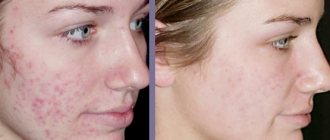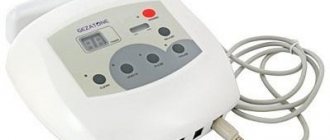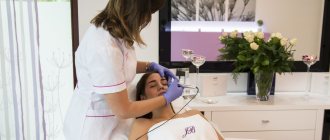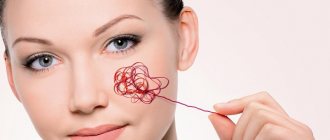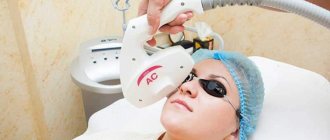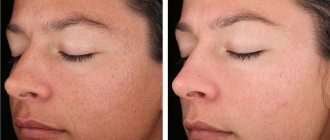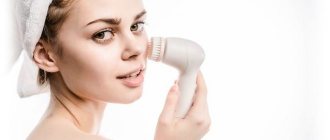When facial cleansing is recommended for rosacea, you need to clearly understand what types of procedures are absolutely not suitable in this situation. The presence of rosacea limits many peels, but there are various compromise options to cleanse the skin without worsening its condition. In case of rosacea, it is definitely worth avoiding deep and aggressive effects on the skin due to the fact that blood vessels may be damaged, which will lead to severe inflammation and even spread of the disease to other uninfected areas of the body.
For couperose skin, you need to choose a gentle and non-traumatic type of cleansing. As a rule, cosmetologists know which procedures are suitable in such a situation. For example, glycolic peeling for rosacea is common, although this is not the only option.
Important! Develops rosacea due to circulatory problems. The vessels dilate and lose their elasticity, which is why the skin is constantly red, and dark stars and nodules may appear on it. At risk are people with sensitive and thin skin, which quickly becomes red and is easily injured.
Why not all types of peelings are suitable for skin with rosacea
Any cosmetic manipulation of the skin leads to an impact on the blood vessels located in it. With rosacea, capillaries become fragile, as a result of their damage, hematomas and bluish spots are formed, giving the skin an unaesthetic, unkempt appearance . The initial stage of rosacea with dry facial skin is characterized by persistent redness, itching and peeling of the skin; with oily skin, such manifestations may be absent. The next stage of rosacea is the appearance of telangiectasia (spider veins and spider veins), most often on the cheeks and wings of the nose. Persistent red spots appear on the skin, and blood vessels “crawl” to the surface - there is every reason to consider such skin to be sensitive , this means that peeling for rosacea skin can only be superficial, extremely soft and gentle, and in advanced cases, problem areas are better cleaned do not expose it at all.
Recovery period
Lasts from two days to a week. Skin after peeling
- red, like a sunburn,
- painful (we remember that there were sharp particles of coral left in it),
- edematous,
- tightened.
It is very painful to touch her. If the procedure was performed not on the face, but, for example, on the back, one can only sympathize with the patient. These days, it is recommended to change the pillowcase on the pillow or the entire set of bed linen daily, after carefully ironing it to minimize the risk of germs getting on injured skin.
After 2-3 days, it begins to peel off greatly, sometimes becoming literally like a terry towel, in other cases coming off in large flaps, like after being burned in the sun.
In places, crusts form on the skin that cannot be touched.
Maintaining a normal lifestyle for several days becomes problematic, since your appearance may cause confusion among others.
Back to the beginning of the article
Couperose skin and chemical peels
Milk peeling. Even in small concentrations, lactic acid has whitening and anti-inflammatory properties, gently exfoliates dead cells, moisturizes and strengthens the skin, and makes the skin less sensitive to UV rays. Milk peeling does not cause irritation even to very sensitive skin prone to allergic rashes. Find out more about milk peeling.
Almond peeling. A comfortable type of superficial cleansing, suitable for tanned and dark skin. Mandelic acid minimally irritates the skin; the cosmetologist can easily control the intensity of peeling and the depth of penetration of the drug. Find out more about almond peeling.
Phytin peeling. Perfect for mature skin with rosacea. Phytic acid molecules, due to their large size, are not able to penetrate deeper than the upper layers of the epidermis, so the peeling is definitely superficial, fully meeting the requirements for compositions approved for use on skin with rosacea. Find out more about phytin peeling.
Azelaine peeling. Azelaic acid, which is part of it, has antibacterial and soothing properties. Peeling based on azelaic acid is useful for both rosacea and rosacea (rosacea often occurs on skin with rosacea), acne and other dermatological diseases. Learn more about azelaine peeling.
Lactobionic peeling. It is used relatively recently in cosmetology. Lactobionic acid is known for its stabilizing properties and is used in medicine for organ transplantation and for the preparation of antibacterial drugs. Lactobionic peeling minimally irritates the skin, so it is used to cleanse sensitive skin, including those with rosacea and acne.
In addition, for rosacea skin, you can use some types of Renofaz peels, as well as TCA peels and retinoic peels (the last two are not always and with a minimum concentration of the active substance).
Attention: there is an opinion that glycolic and salicylic peels cannot be used for skin with rosacea, although the exact opposite opinion can be found on the Internet.
In addition to the listed surface acid peels, enzymatic (aka enzyme) peels based on papain, bromelain, trypsin and lactic enzymes are suitable for couperose skin. Many cosmetic peeling compositions for skin with rosacea. Some of them and estimated prices for cleansing procedures using them:
| Name of peeling for skin with rosacea | Manufacturer | Price of the procedure, from |
| Lactipeel, Argipeel, Mandelac | SesDerma, Spain | 2,000 rubles |
| Soft Peeling | Alcina, Germany | 2,100 rubles |
| Bio Phyto Peeling | Christina, Israel | 3,100 rubles |
| Easy Phytic Solution | Skin Rebirth SL, Spain | 1,500 rubles |
Salicylic acid
Where he lives. Willow bark, rose flowers, chamomile and calendula. It is also synthesized artificially from phenol.
Chips. Fat soluble. Well dissolves sebum inside the pores, loosens the stratum corneum. The main acid for oily problem skin. Active (aggressive), but at the same time it has a fairly large molecule and does not penetrate deeply. Acts as an enhancer for other substances. Natural preservative. Antioxidant.
What is he doing. Deeply cleanses pores, prevents clogging, regulates the activity of sebaceous glands, relieves inflammation, disinfects, fights acne and post-acne.
What skin type is it suitable for? Oily, problematic with hyperkeratosis, acne and post-acne.
Important! Causes photosensitivity (sensitivity to the sun). Incompatible with resorcinol, zinc oxide and contraindicated if allergic to aspirin.
Features of peeling couperose skin
- In problem areas, the peeling composition is applied last and neutralized first.
- For skin with rosacea, the course includes a smaller number of procedures compared to skin without vascular network.
- The breaks between peeling sessions for rosacea are extended to two weeks.
- During the post-peeling period, it is recommended to take (orally) drugs - angioprotectors (to strengthen the walls of blood vessels). These can be: ascorutin, troxevasin, venoruton or tinctures of arnica, hawthorn, horse chestnut, cypress, fir, juniper. Multivitamin complexes containing vitamins P and K are useful.
- To care for your skin after the procedure, you need to choose nourishing creams and masks that contain: grape seed oil, sweet almond or jojoba oil, as well as mallow extract, hyaluronic acid and plant collagen.
Answers on questions
Can scrubs be used for rosacea?
Scrubs can be used only in cases where long-term remission is observed. But you need to choose products with minimal abrasiveness.
How often should you peel for rosacea?
The procedure cannot be repeated often. It is acceptable to perform it once every 2 weeks for 1.5 months, after which there should be a break for 3 weeks.
What restrictions should be followed if there is rosacea?
To achieve stable remission, it is forbidden to visit the sauna, bathhouse, or solarium. It is important to monitor your diet: give up alcohol, spicy foods, coffee, chocolate.
Reviews from those who have already tried it
Anna, 27 years old:
I was pleased with the results after milk peeling. It is more gentle (compared with glycolic), there is no irritation or redness after the procedure. The skin became fresher.
Lyudmila, 33 years old:
Coral peeling helped me a lot. There was a vascular network that almost disappeared after 5 procedures.
Margarita (cosmetologist, work experience – 15 years):
Azelaine peeling is a great thing for rosacea. You can use products that act superficially: these are milk, almond, phytic, and also enzymatic. The interval between procedures must be at least 14 days. Be sure to strengthen the blood vessels after the procedure. It is also important to thoroughly moisturize your skin.
How much does peeling for skin with rosacea cost? Price of the procedure in the salon
The price of peeling skin with rosacea depends on the method of treating the skin, the composition used and the level of the cosmetology establishment providing the service.
| Peeling | Type of superficial peeling | Price from |
| Milk peeling | chemical | 1,500 rubles |
| Almond peeling | chemical | 4,000 rubles |
| Phytin peeling | chemical | 2,500 rubles |
| Azelaine peeling | chemical | 2,000 rubles |
| Lactobionic peeling | chemical | 2,000 rubles |
| Peeling Renofaz | chemical | 2,500 rubles |
| Ultrasonic peeling | hardware | 1,100 rubles |
What else you need to know about peeling and skin care with rosacea
Substances harmful to skin with rosacea: clove and eucalyptus oils, honey, menthol, mint, aloe vera. Experts also do not recommend using creams with fruit acids, hard scrubs, film masks and masks that harden on the skin. Soap, tap water, lotions (alcohol) should be excluded from daily care for skin with spider veins, especially after recent peeling of rosacea skin.
It is best to cleanse skin with rosacea with For home peeling of rosacea skin, you can use gommages that do not contain coarse abrasives. Regular use of serums and creams containing extracts of licorice, butcher's broom, green tea and vitamins A, E, C and K will help reduce the manifestations of rosacea.
Skin with rosacea reacts sharply to the sun's rays , so before going outside, you should apply sunscreen. This needs to be done constantly, and not just after peeling skin with rosacea!
To prevent rosacea from progressing , you should refrain from visiting the sauna, steam bath and solarium, and also limit the consumption of alcoholic beverages, especially red wine. In general, nutrition plays an important role in the prevention and treatment of rosacea. Restrictions apply to spicy and very hot foods, as well as coffee, chocolate, and chokeberry drinks.
Red dilated vessels can be “camouflaged” - for this, skin correctors with green or yellow pigment are used.
You should avoid cosmetic procedures accompanied by a rush of blood to the face and techniques that require heating or sudden cooling of the skin. Not only vaporization, steaming compresses and cryotherapy are prohibited, but also manual cleaning, classic manual facial massage, and vacuum cleaning.
For rosacea, elos-rejuvenation and photo-rejuvenation sessions will be useful. At the initial stage of rosacea, you can do sessions of microcurrent therapy and radio wave lifting. If the skin is simultaneously affected by rosacea and acne, ultrasonic peeling is suitable for cleansing it. The heat characteristic of these hardware procedures has a beneficial effect on the skin: it improves microcirculation and activates metabolic processes.
Possible side effects
- a pustular rash due to bacteria coming into contact with the skin during or after peeling and the development of inflammation, usually goes away on its own when the protective functions of the skin are restored, or is removed during the next pre-peeling cleansing;
- exacerbation of herpes - this reaction to peeling occurs quite often, therefore, if you have herpes rashes, it is better to take a course of acyclovir as a preventive measure before the procedure;
- hyperpigmentation is the appearance or intensification of an existing one, sometimes this is an individual reaction of the skin to peeling, but most often occurs when sunscreen is neglected after the procedure.
Back to the beginning of the article


